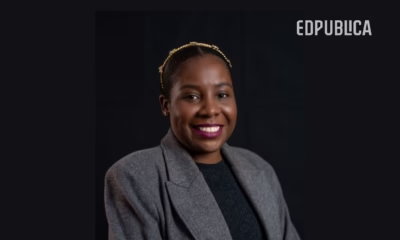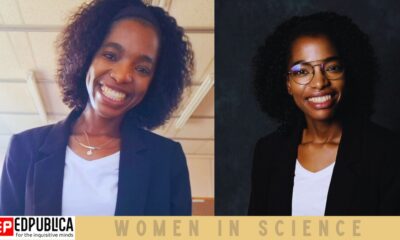Women In Science
The Data Don’t Lie: Women Are Still Missing from Science — But Why?
Despite two decades of progress, women remain just one in three researchers worldwide. Global datasets reveal how systemic filters — from classrooms to laboratories and limited mentorship access — continue to push women to the margins of science
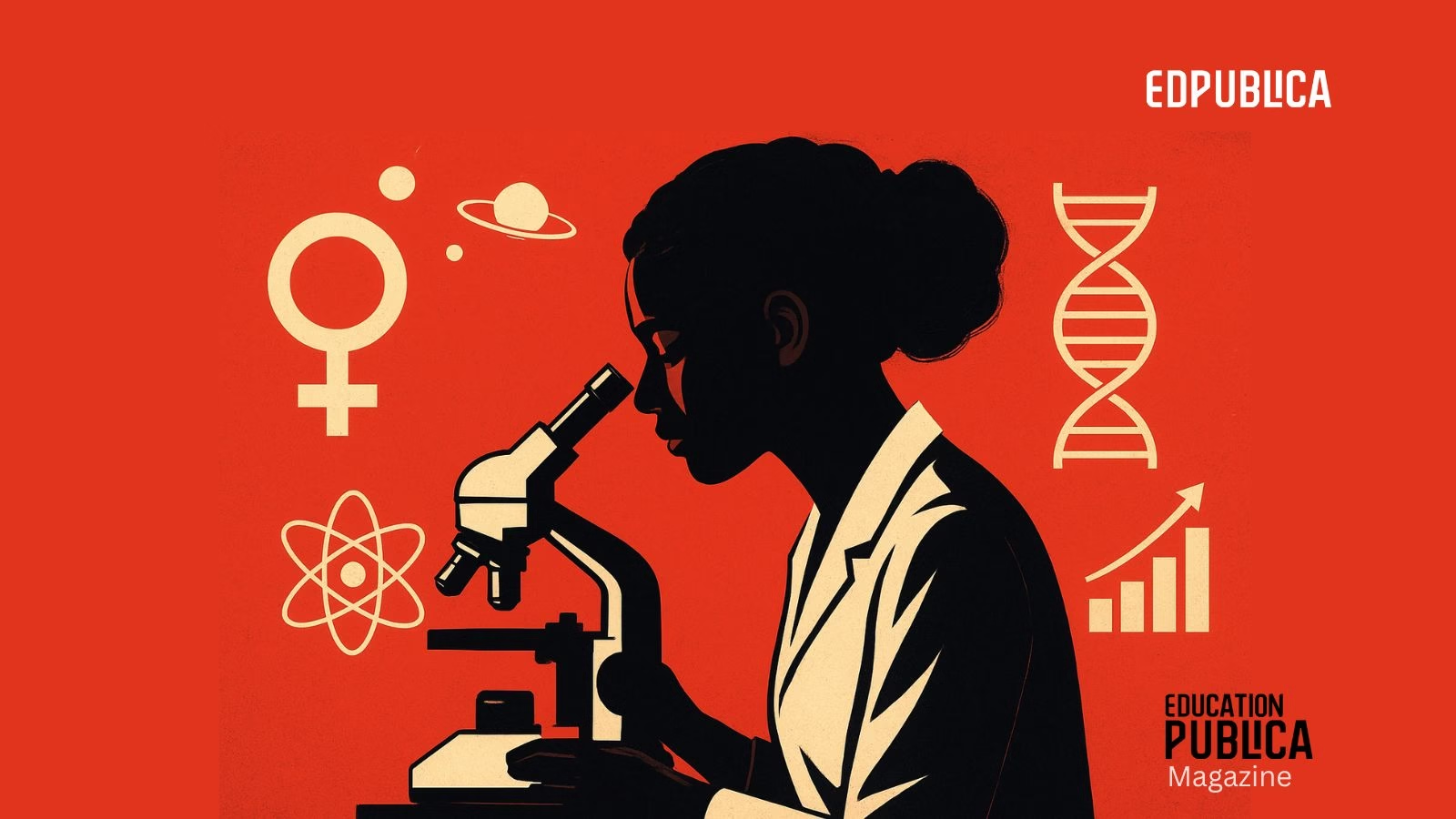
When a young astrophysicist in Buenos Aires packed up her telescope after her PhD, she had every intention of continuing her research. Five years later, she works in data analytics, far from the night skies she once studied.
EdPublica met her by chance at Kuala Lumpur airport. Her story is echoed across continents — from lab benches in Lagos to computing centres in Bengaluru — where women enter science full of promise, only to find themselves on the margins of it.
According to UNESCO’s latest data, only one in three researchers worldwide is a woman — a number that has barely moved in two decades. For all the progress in girls’ education and gender equality elsewhere, science — the very field meant to advance humanity — remains caught in an old equation that continues to leave women out.
The slow revolution
‘UNESCO’s Status and Trends of Women in Science (2025)‘ reveals a striking paradox: more women than ever are pursuing higher education, yet their presence in scientific research and leadership has barely expanded.
Globally, women account for about 35 percent of graduates in STEM fields, but that average conceals deep divides. In life sciences, they have reached near parity. In engineering, physics, and computing, their numbers plummet below a quarter.
“Girls are not opting out of science,” says Shamila Nair-Bedouelle, UNESCO’s Assistant Director-General for Natural Sciences. “They are being filtered out by systems that were never designed for them.”
That “filter” begins early. Subtle stereotypes about what girls are “good at” shape subject choices long before university. The absence of visible role models compounds the message.
Dr. Julia Puseletso Mofokeng, Senior Lecturer in Chemistry at the University of the Free State, South Africa, recalls that absence vividly:“When I was doing my honours degree, I was the only female student in a class of six. Later, in a research group, I found myself surrounded by men. During international collaborations, out of 18 participants, I was the only woman. That realization motivated me — I decided that if I wanted to see more women in science, I had to be that role model,” she tells EdPublica.
Her reflection captures a global truth: women’s participation rises where mentorship and visibility intersect. Where they don’t, even ambition finds itself isolated.
From classrooms to corridors of power
Getting a degree is only the first hurdle. The next — and far harder — challenge is staying in the system. UNESCO data show that women hold just one-third of research positions globally, dropping to around 22 percent in G20 nations.
In industrial and corporate R&D, the numbers shrink further. Temporary contracts, uneven access to grants, and opaque promotion systems form invisible barriers. Even where hiring begins on equal footing, women’s participation thins out with every rung of seniority.
A 2025 bibliometric analysis of 80 million scientific papers found that men dominate the top ten percent of most productive and cited researchers in almost every field. Women start at comparable rates but face higher attrition and fewer opportunities to lead multi-author studies or secure large grants.
“Science is not short of capable women,” says Dr. Claudia Ntsapi, a researcher at the University of the Free State, in conversation with EdPublica.
“Systemic barriers — gender bias, lack of mentorship, limited resources — continue to hinder true equality in science careers.”
She points to South Africa’s paradox: women make up the majority of university graduates, yet only 13 percent of STEM graduates are women, and Black women remain severely underrepresented in leadership.
“We need mentorship networks, scholarships, and policies that promote work-life balance. And we must raise awareness about the contributions of women in science to challenge the stereotypes that keep girls away,” Dr. Claudia adds.
The gender of knowledge
The problem, UNESCO argues in its Call to Action: Closing the Gender Gap in Science (2024), is not merely one of representation — it’s one of perspective. Who participates in science shapes what science studies, and how it studies it.
When most clinical research was designed around male physiology, women’s health outcomes suffered. When engineers ignored how climate disasters displace caregivers, adaptation models missed critical social realities.
“Science cannot be sustainable if it is exclusive,” UNESCO notes. “Gender equality is a prerequisite for scientific excellence.”
Mathematician Professor Neena Gupta, recipient of the Infosys Prize 2024 in Mathematical Sciences, agrees that inclusion isn’t charity — it’s strength. In her interview with EdPublica, says, “Women constitute half of our strength and are equally capable of contributing to science and mathematics. But they often shoulder additional family responsibilities. With the right support — from family, government, and institutions — women can contribute freely to science and technology.”
Why women leave
Behind the statistics are systems built on old assumptions — that a researcher’s productivity must be uninterrupted, that career gaps signal lack of commitment, that caregiving is a private burden.
Across countries, more than 70 percent of women in research are on temporary or part-time contracts, compared to 55 percent of men. When funding tightens, they are often the first to go. Maternity leave resets grant eligibility. Mentorship networks skew male, perpetuating cycles of exclusion.
Dr. Laura Monk, a Royal Society Dorothy Hodgkin Fellow and Lecturer at the University of Bristol (UK), captures this invisible struggle, “Mathematics is indeed a very masculine field. I’ve been lucky not to face overt sexism, but I struggled deeply as one of the only girls in my cohort. Finding female mentors and peers was crucial — it gave me a sense of belonging and purpose. That’s what many young women lack: the feeling that they belong here.”
Professor Neena Gupta echoes that sentiment from India’s perspective, “there are now more women in mathematics than there were earlier, and the number is growing. Having role models helps. We must continue supporting these women so young girls can see proof that they too can succeed.”
Flickers of progress
Still, the global picture is not uniformly bleak. Central Asia now hovers near gender parity in research, and Latin America’s public research systems have pushed women’s representation close to 45 percent. Eastern Europe has stabilized near 40 percent.
In Asia, change is slower but visible. India reports that 43 percent of PhD students are women, yet only about 18 percent work in industrial R&D. Government initiatives like KIRAN, Vigyan Jyoti, and SERB’s POWER grants are slowly rewriting that equation by funding re-entry fellowships and supporting mid-career researchers.
“I have faced the challenges most women face — balancing family, raising children,” says Professor Gupta. “But I was fortunate to have a supportive family that shared my responsibilities. That support made it possible for me to focus on research.”
Her story, echoed in laboratories across continents, underlines a pattern: where family and institutional support converge, women stay and thrive. Where they don’t, science loses talent it cannot afford to waste.
Leadership and the glass microscope
If entry and retention are the first two bottlenecks, leadership is the third. Less than 15 percent of national science academy fellows are women. Nobel Prizes, large-scale grants, and directorships of major research facilities remain overwhelmingly male.
Promotion criteria reward uninterrupted publication and global visibility — metrics that inherently penalize those who take career breaks. “It’s not that women aren’t producing excellence,” UNESCO notes. “It’s that the system measures excellence through a lens that erases them.”
The Call to Action lays out a clear roadmap: transparent promotion processes, gender audits for research grants, institutional accountability, and gender-responsive budgeting. It calls on governments to publish annual data — because what isn’t measured isn’t fixed.
India in the global equation
India’s story sits at the intersection of progress and persistence. Female enrolment in STEM has surged, and the country now ranks among the top producers of women science graduates. Yet in leadership, the gap yawns wide.
Only one in four senior faculty positions in India’s universities is held by a woman. In industrial research, that number drops to one in five. Cultural expectations and workplace rigidity continue to limit re-entry for mid-career women.
But India’s policy landscape offers lessons: the Department of Science and Technology’s women-focused grants, INSPIRE fellowships, and the inclusion of gender equity in the National Science and Technology Policy draft all point toward systemic change — if implementation follows intent.
Why it matters now
Women’s equal participation in science is not a “women’s issue.” It is a scientific, developmental, and democratic imperative. Every dataset or discovery that excludes half the population leaves the world poorer in ideas.
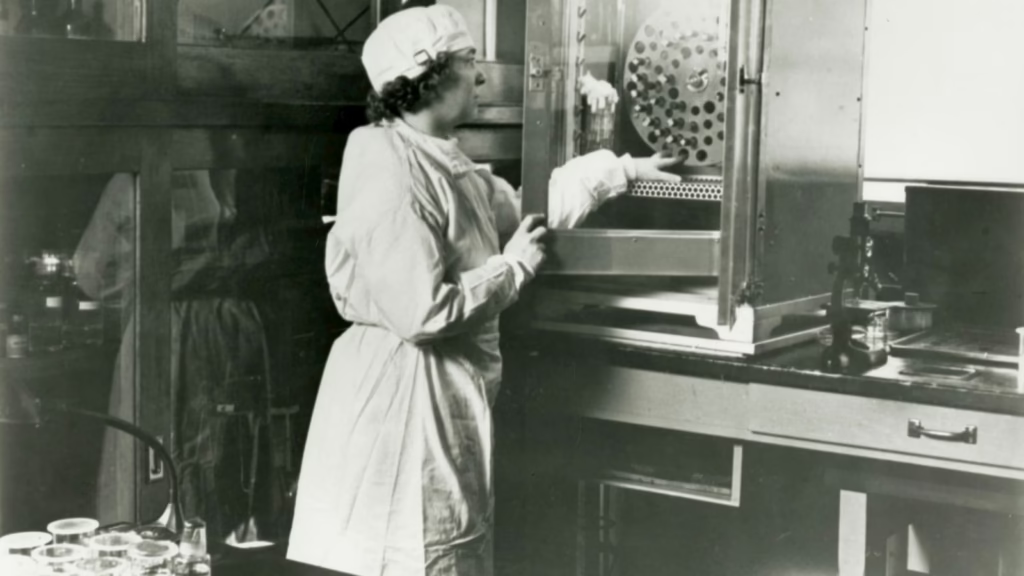
UNESCO’s twin reports — one analytical, one urgent — make the same argument: the gender gap in science is measurable, correctable, and indefensible. Closing it is not about fairness alone; it is about unlocking the full imagination of science itself.
As Dr. Mofokeng puts it, “if I wanted to see more women in science, I had to be that woman.”
The next generation shouldn’t have to say the same.
Note: This story is part of the EdPublica Women in Science Initiative, an ongoing global editorial effort to document the data, experiences, and policies shaping women’s participation in research and leadership. The series celebrates women in science while examining mentorship networks, policy interventions, and structural inequalities in depth. Readers and researchers are invited to share insights or stories with EdPublica’s Women in Science Desk, contact@edpublica.com, or dipin@edpublica.com
Women In Science
Dr Tafadzwa Maramura: Leading the Fight for Clean Water Access in Africa
Dr Tafadzwa Clementine Maramura has dedicated her academic career to tackling one of the continent’s most urgent challenges — sustainable water governance

As Africa grapples with deepening water insecurity, a trailblazing researcher at the University of the Free State (UFS) is stepping into the global spotlight with a mission: to ensure every African has access to clean, safe water.
Dr Tafadzwa Clementine Maramura, a Senior Lecturer and NRF-Rated Researcher in the Department of Public Administration and Management at UFS, has dedicated her academic career to tackling one of the continent’s most urgent challenges — sustainable water governance. Her commitment was recently recognised with a historic appointment as the first black African woman to serve as Secretary of the Institutional Governance and Regulations Framework, a specialist subgroup within the International Water Association (IWA).
“Water is a basic human right, you can survive without electricity and other luxuries, but not without water. Each time you brush your teeth or flush your toilet with at least 15 litres of clean water or you are watering your garden with clean water, there are people that actually don’t have access to basic drinking water,” said Dr Maramura in a statement emailed to EdPublica.
“My research focuses on water governance and sustainable service delivery, public policies, and the green economy in the African, as well as the South African, context
The statistics underscore the urgency. According to Greenpeace, more than 1.34 billion Africans — over 90% of the continent’s population — face some form of water insecurity. The United Nations World Water Development Report 2024 also reports that 2.2 billion people worldwide lack access to safely managed drinking water.
Dr Maramura’s research is rooted in understanding how governments, particularly in Africa, can bridge this glaring gap. “My research focuses on water governance and sustainable service delivery, public policies, and the green economy in the African, as well as the South African, context,” she explained. “What I found is interesting and really saddening at the same time. When you break it down, you realise that one in every three people in Africa don’t have access to potable water.”
But for Dr Maramura, this issue is more than a policy problem — it’s a deeply personal and gendered one. “Access to clean water is not just a basic need; it is a matter of dignity, equality, and survival. As a young African woman, through my research, I see first-hand how the burden of water scarcity falls disproportionately on women and girls, robbing us as women, of education, economic opportunities, and health.”
“But we are not just victims – we are leaders in this fight. By empowering women and investing in sustainable water solutions, we can transform our communities and break the cycle of poverty. The time for action is now because water is life, and every African deserves it.”
Her upcoming book chapters, to be released in June, explore the water-health nexus in fragile states — aligning two of the Sustainable Development Goals (SDGs): Goal 3 (Good Health and Well-being) and Goal 6 (Clean Water and Sanitation). She stresses the interconnectivity of these issues.
“You cannot solve problems in isolation; you cannot look at the water problem in isolation. If you have a water problem, you have a health and education problem because kids can’t go to school if there is no water. Hospitals can’t function when there is no water,” she said. “How can we ensure that we merge the two together and ensure researchers working on health and water can find common ground to address any challenges arising from the lack of water so that we don’t have these health issues?”
Despite being an upper-middle-income country, South Africa continues to face major water delivery issues, especially in rural and impoverished areas. Millions still rely on ventilated pit latrines due to lack of access to modern sanitation.

Dr Maramura believes there is no one-size-fits-all solution but emphasizes a collaborative, inclusive approach. “There is work that needs to be done. The government, private sector, the communities, as well as other role players need to work together. South Africa is a water-stressed country with rainfall below the global average. We realised that we have scarce groundwater resources.”
She calls on communities to become more informed and involved. “The community needs to understand, participate, and be aware of how much damage we can do by just drilling boreholes and digging wells.”
On the role of the private sector, she notes: “They need to know what it is that they can do to ensure that they also play a part through their corporate social responsibility and philanthropic dimensions in assisting the community.”
And for government, she adds: “The policies are there. The government needs to consult with the communities, the private sector, and all other relevant stakeholders. They need to involve affected communities and after consultations, they need to engage these communities because they understand their problem best.”
Through her research, advocacy, and international leadership, Dr Maramura is not only asking the hard questions about water governance — she’s working to reshape the answers for the future of Africa
Women In Science
Neena Gupta: Shaping the Future of Algebraic Geometry
She was awarded the Infosys Prize for her groundbreaking work on the Zariski Cancellation Problem, a fundamental question in algebraic geometry first posed in 1949 by Oscar Zariski, one of the pioneers of the field

EdPublica has the privilege of speaking with Professor Neena Gupta, the recipient of the prestigious Infosys Prize 2024 in Mathematical Sciences. Professor Gupta is a faculty member in the Theoretical Statistics and Mathematics Unit at the Indian Statistical Institute, Kolkata. She was awarded the Infosys Prize for her groundbreaking work on the Zariski Cancellation Problem, a fundamental question in algebraic geometry first posed in 1949 by Oscar Zariski, one of the pioneers of the field. In 2014, she made a striking contribution by proving that Asanuma’s 3-dimensional affine variety provides a counterexample to Zariski’s original Cancellation Problem in positive characteristic. Her solution to this long-standing problem, which challenges a key assumption about the structure of affine varieties, has had a profound impact on both algebraic geometry and commutative algebra.

In this interview, we discuss the inspiration behind her research, the broader implications of her work, and the challenges she has faced as a woman in a historically male-dominated field. Professor Gupta also shares valuable insights for young aspiring mathematicians, offering advice on how to navigate the complexities of both academic life and career development.
Dear Madam, congratulations on winning the Infosys Prize 2024 in Mathematical Sciences! How does it feel to receive this prestigious recognition for your work on the
Zariski Cancellation Problem?
I am very happy to receive this recognition. It gives me a sense of fulfillment that the broader mathematical community (not just experts in my area) and society are recognizing the importance of my work.

Your work has had a significant impact on affine algebraic geometry. What was the initial inspiration or motivation behind pursuing this area of research, and what makes this problem so fundamental in algebraic geometry?
I first became aware of this area of research through lectures in algebra seminars delivered by Professor Amartya Kumar Dutta, long before he became my official supervisor. Some of the fundamental problems in this area are simple to state, and even an MSc student can understand and appreciate their importance. My curiosity to learn more about them motivated me to study the literature in this area and eventually pursue research under the supervision of Professor Dutta.

Can you briefly explain the Zariski Cancellation Problem to our readers and describe the significance of your solution in resolving this long-standing question?
The problem asks: if the affine cylinder over an affine variety is isomorphic to an affine space, does it mean that the affine variety is necessarily isomorphic to an affine space? I was the first to show that an affine 3-dimensional variety, constructed by T. Asanuma, is a counterexample to the Zariski Cancellation Problem in positive characteristic.
Your result answers the Zariski Cancellation Problem in the negative for positive characteristic. What are the broader implications of this breakthrough in algebraic geometry and commutative algebra?
The affirmative solution to the Zariski Cancellation Problem by Fujita, Miyanishi, Sugie, and Russell for two-dimensional space has been applied in several problems, leading to new theories. Therefore, it was desirable to know whether cancellation could occur in higher dimensions. My solution to the problem is negative, providing a crucial check for mathematicians to avoid the mistake of assuming cancellation in higher dimensions.
Your work on this problem revealed unexpected connections between various mathematical concepts. Can you give us an example of one such connection, and how it may influence future research in these fields?
I developed a theory that revealed surprising connections between the Zariski Cancellation Problem and other fundamental problems such as the Characterisation Problem, the Epimorphism Problem, and the Affine Fibration Problem. The theory simplified the technical arguments in my earlier papers, provided deeper insights into recent breakthroughs (including my own results), and may have paved the way for new discoveries. I used ideas from this theory to construct higher-dimensional counterexamples to the Zariski Cancellation Problem in positive characteristic.

You have achieved significant milestones in your career, including being one of the youngest recipients of the Shanti Swarup Bhatnagar Prize and the Nari Shakti Puraskar. As a woman in a field that has historically seen fewer women, what challenges have you faced, and what advice do you have for young women aspiring to build careers in mathematics and science?
I have faced the challenges that most women face, such as balancing family responsibilities, especially raising children. Fortunately, I have not faced any discrimination in the workplace, and I have a supportive family that has always shared my responsibilities, allowing me to focus on my research.
Do you think the landscape for women in mathematics and science has evolved over the years? What steps can be taken to further encourage young girls and women to pursue careers in these fields?
Certainly, there are now more women in mathematics than there were earlier, and this number is only going to increase. Having role models in this area always helps. We need to continue supporting these role models and ensure that young girls see these women as proof that they too can succeed in mathematics and science.
As a role model, how important is it for women to be represented in the mathematical sciences, and how can institutions and mentors better support women in advancing their careers?
Women constitute half of our strength, and they are equally capable of contributing to basic science and mathematics—in fact, in almost all areas of life. However, they often take on additional responsibilities within the family. With the support of family, government, and institutional measures, women can also contribute freely to the development of science and technology.

The field of algebraic geometry continues to evolve rapidly. What are some of the emerging areas within this field or in related fields that excite you, and what questions are you most eager to explore in your future work?
I find the embedding problem of Abhyankar-Sathaye very exciting. It presents an intriguing challenge, and I am eager to explore the deeper connections it may have with other areas in algebraic geometry.
As a winner of the Infosys Prize, you will undoubtedly inspire the next generation of mathematicians. What message would you like to share with young researchers who are just starting their journeys in mathematics and science?
It may initially seem difficult, but hard work and perseverance always pay off. I would urge young researchers to start early, focus on concepts, pursue research in areas they are passionate about, and not be intimidated by the size or complexity of problems. Keep pushing forward, and you will make breakthroughs in time.
Women In Science
How Dr. Julia Mofokeng is Rewriting the Story of Plastic Waste
Her innovative research on biodegradable polymers offers a promising solution to the global plastic pollution crisis
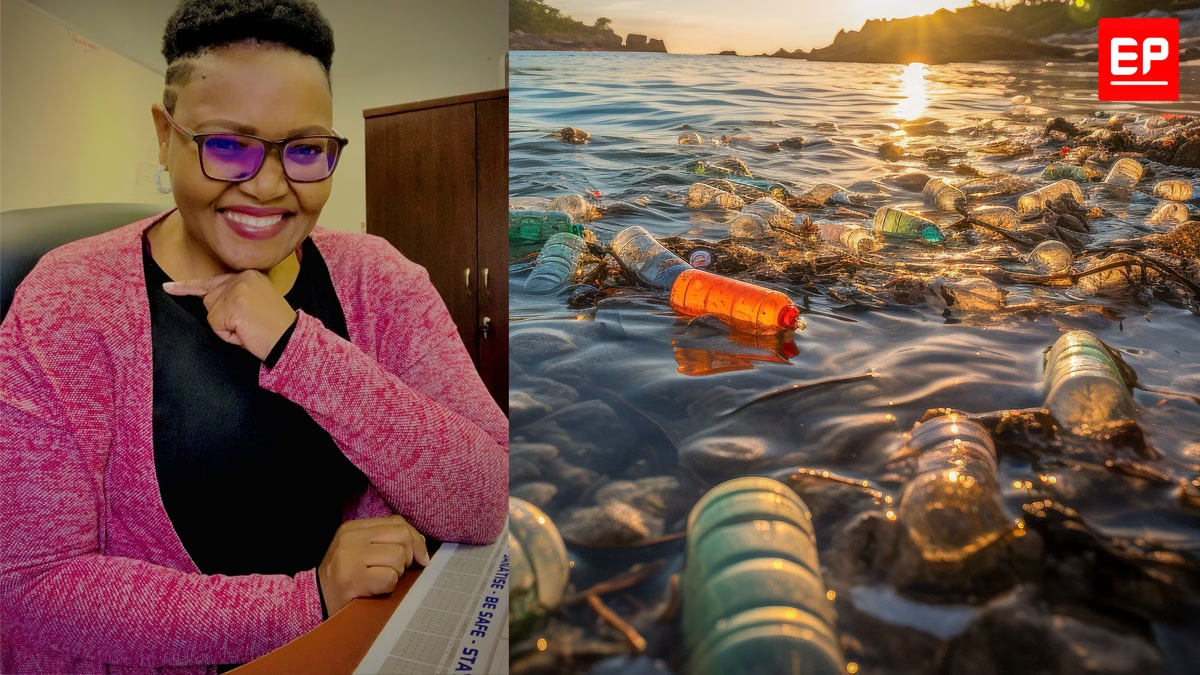
EP WOMEN IN SCIENCE introduces Dr. Julia Puseletso Mofokeng from South Africa, whose journey from research assistant to respected scientist reflects her perseverance and dedication to the field of science. Her innovative research on biodegradable polymers offers a promising solution to the global plastic pollution crisis. These large, chain-like molecules provide an environmentally friendly alternative to petroleum-based plastics. Dr. Mofokeng’s story will undo-ubtedly inspire more women to pursue and excel in scientific careers.
Julia Puseletso Mofokeng, a Senior Lecturer and Researcher in the Department of Chemistry at the University of the Free State (UFS), is contributing to the global fight against plastic pollution through her innovative research on biodegradable polymers—large, chain-like molecules that provide an environmentally friendly alternative to petroleum-based plastics. As she advances her research into polymers that degrade naturally, Dr. Mofokeng is playing a crucial role in addressing one of the most pressing environmental challenges of our time.
A Spark of Curiosity: The Early Years
Dr. Mofokeng’s path to becoming a scientist was anything but typical. Her journey began not in a traditional ecosystem but in a research laboratory at the University of the North, Qwaqwa Campus, in 1999. “I was appointed as a Research Assistant, responsible for cleaning the postgraduate research labs,” she recalls. “But it wasn’t just cleaning—I became fascinated by the experiments and projects the researchers were working on.”
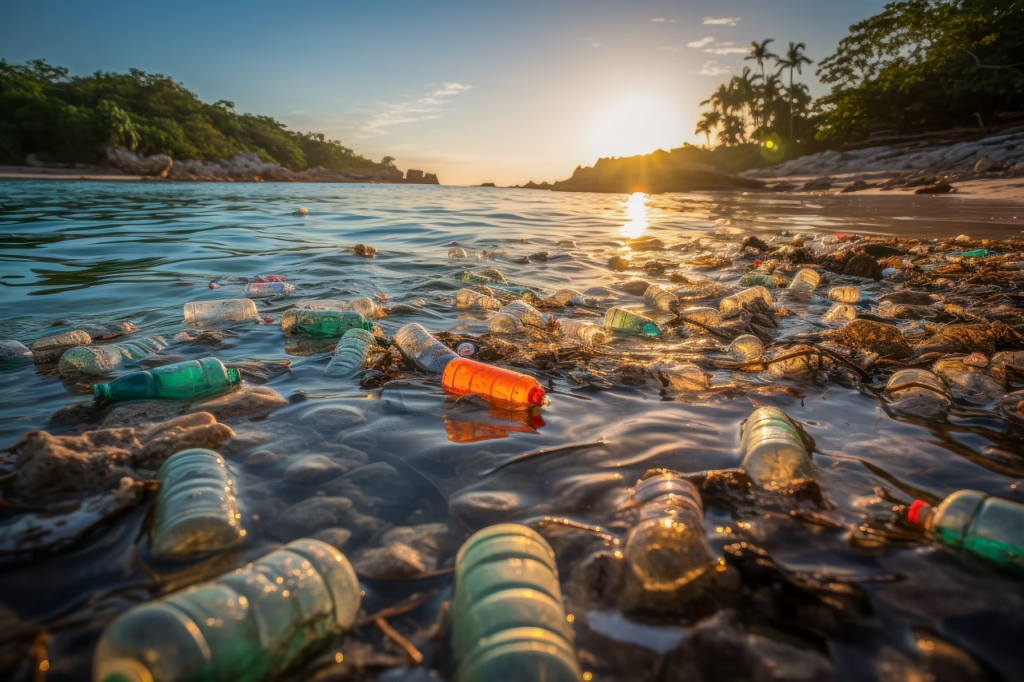
The laboratory was a vibrant place, with researchers studying a variety of topics, including anti-cancer drugs and polymer science. “I would clean quickly so I could watch them work. They were kind enough to let me help with some tasks, and over time, I learned a lot from them. It sparked something in me,” Dr. Mofokeng explains.
Her passion for science blossomed even though she had no formal science background from secondary school. The experience ignited her curiosity, leading her to pursue an undergraduate degree in chemistry. “At first, I didn’t think I could study science at a university level, but my mentors saw potential in me. They encouraged me to keep going and helped me realize that I could pursue a career in this field,” she says.
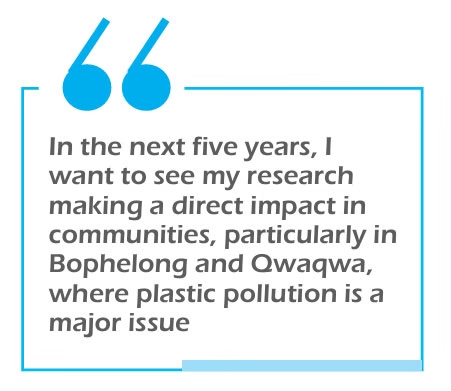
In 2003, after the University of the Free State merged with Qwaqwa Campus, Dr. Mofokeng was able to enroll in the Bachelor of Science (B.Sc.) degree program, beginning with the Extended Program due to her non-traditional academic background. “It was a struggle, but I worked hard. My mentors, particularly Prof. Joseph Bariyanga, pushed me to keep learning and growing,” she recalls.
From Research Assistant to Researcher
By 2008, Dr. Mofokeng had completed her B.Sc. degree and decided to pursue an Honours degree in Polymer Science. It was during this time that she began to focus on the environmental issues that would shape her career. “I had always been concerned about plastic waste in my community. I realized that finding alternatives to petroleum-based plastics could help address this growing environmental problem,” Dr. Mofokeng shares.
Her decision to pursue biodegradable polymers was driven by a personal desire to contribute to environmental sustainability. She embarked on her Honours research project under the guidance of Dr. Buyiswa Hlangothi, exploring thermoplastic starch sourced from corn starch for possible applications in packaging. “My research involved studying biodegradable polymers that could replace petroleum-based plastics, and I felt this was an area where I could make a real impact,” she says. This research formed the foundation of her Masters and eventually PhD work.
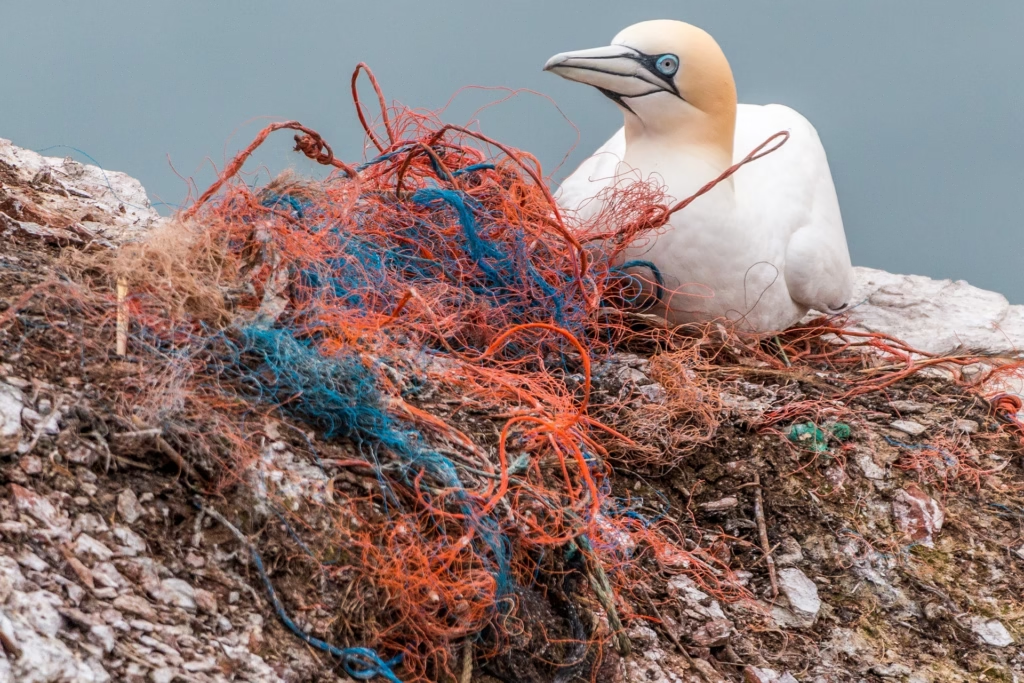
Her Masters research, conducted under the supervision of Prof. Adriaan Luyt, took her to Hungary in 2009, where she worked on a collaborative project comparing biodegradable Polylactic Acid (PLA) and petroleum-based Polypropylene (PP) polymers. The focus was to see if PLA could replace PP for short-shelf-life applications, a common use for disposable plastics. “The results were promising, and it was an eye-opening experience. While in Hungary, I had the opportunity to witness the production of biodegradable packaging materials, like water bottles and toothbrushes, made from PLA and thermoplastic starch,” she recalls.
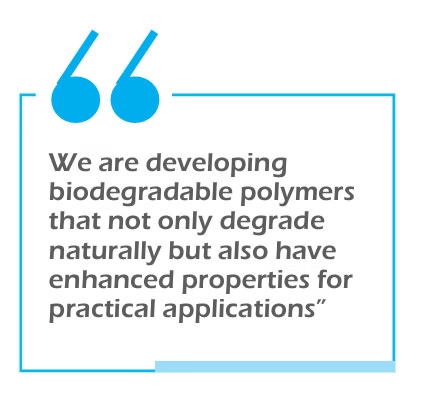
Her work during this time led to her MSc degree in Polymer Science in 2011, and one of her first research papers gained significant attention, receiving over 370 citations on Google Scholar to date. “That publication was a turning point for me,” she says. “It motivated me to continue pushing the boundaries of what was possible with biodegradable polymers.”
In 2011, Dr. Mofokeng began her PhD research, focusing on biodegradable polymer blends and nanocomposites, using titania as a filler. Over the next few years, she published five successful research articles, contributing to her growing reputation as an expert in the field of polymer science. “The success of my research was rewarding, but what mattered most was that it could contribute to solving a major environmental problem,” she says.
Challenges and Triumphs
As a woman in science, Dr. Mofokeng has faced her share of challenges, particularly the lack of female mentors in the early years of her career. “The lack of women mentors and leaders available growing up, made me think and believe that certain positions are made for men only. It was not easy to find strong women role models in my early years of figuring out what I wanted to do,” she admits. However, things began to change as she moved through her university studies, especially in the science faculty, where her lecturers were predominantly female. “Surprisingly my lectures were mostly women. That encouraged me to study hard and succeed because I now had women role models I looked up to,” she says.
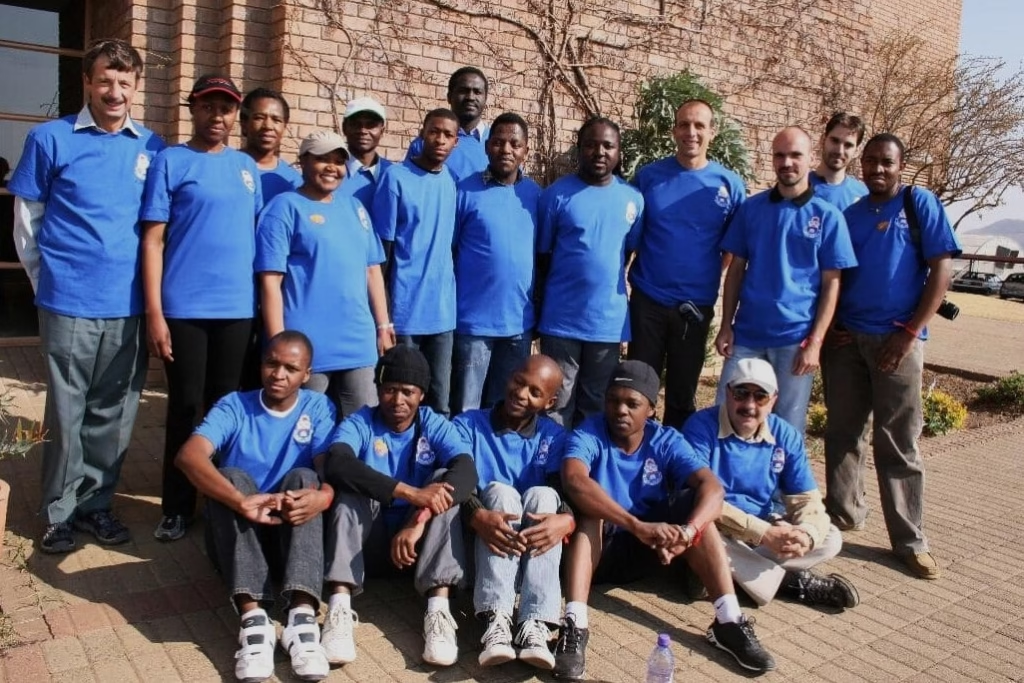
Despite the encouraging presence of female mentors, Dr. Mofokeng’s journey wasn’t without its difficulties. “When I started studying at the university, particularly in the science faculty where the student population was dominated by males, surprisingly my lectures were mostly women. That encouraged me to study hard and succeed because I now had women role models I looked up to,” she recalls. “When I was doing my honours degree, I was the only female student in a class of six. I found myself in a research group with very few women, which was a stark contrast to the male-dominated environment I was used to,” she recalls. “When we had international visitors to our institution, I realized that out of a group of 18, I was the only woman, apart from my two lecturers.”
This realization motivated Dr. Mofokeng to change the narrative. “I decided that if I wanted to see more women in science, I had to be that role model,” she says. She began speaking at events and creating awareness through social media. “I started posting about my milestones—my graduations, my international research experiences, and my achievements—in order to inspire other women to pursue science.”
Her efforts paid off. “The student population in our department has changed. Today, we have many more female students in science, and they are excelling,” she says with pride.
Biodegradable Polymers for Environmental Sustainability
Dr. Mofokeng’s current research focuses on the development of fully biodegradable polymer blends and nanocomposites, designed to address plastic pollution and environmental degradation. “Plastic pollution is a serious global issue. Each year, between 19 to 23 million tonnes of plastic waste leak into aquatic ecosystems, causing significant harm to marine life and ecosystems,” she explains.
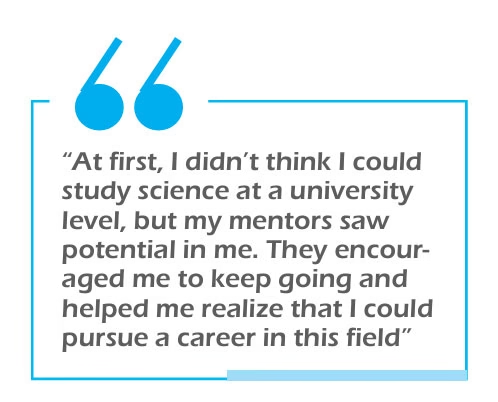
Her work aims to offer a sustainable alternative to petroleum-based plastics, which are notoriously difficult to break down in the environment. “We are developing biodegradable polymers that not only degrade naturally but also have enhanced properties for practical applications,” Dr. Mofokeng explains. “We’re working with a variety of materials—natural fibers, inorganic fillers, and even carbon-based composites—to improve the strength, thermal properties, and flame retardancy of the polymers.”
One of Dr. Mofokeng’s most exciting projects involves using biodegradable polymers to help remove heavy metals from contaminated water. “We are exploring the use of graphene oxide combined with biodegradable polymer blends to remove contaminants like lead from water. This has the potential to address environmental issues in communities where polluted water is a major problem,” she says.
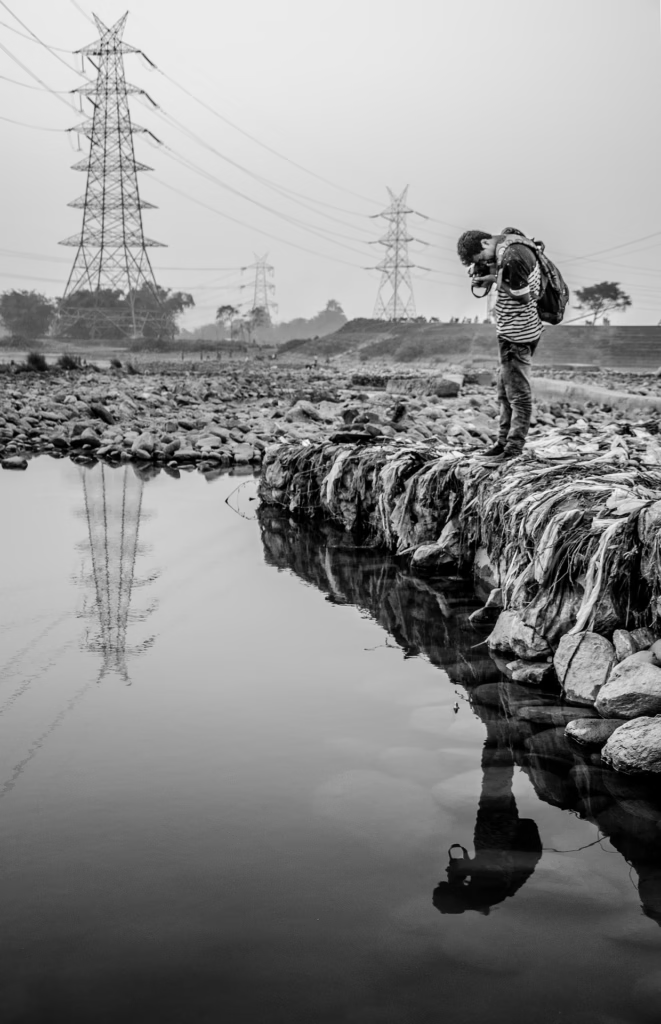
Her work is already yielding significant results, with several articles published in high-impact journals. “The goal is to develop polymers that can be used not only in packaging but also in other critical areas such as medical devices, water purification, and even aerospace materials,” Dr. Mofokeng shares.
Shaping the Future
Looking ahead, Dr. Mofokeng is focused on expanding her research and mentoring future generations of scientists. “In the next five years, I want to see my research making a direct impact in communities, particularly in Bophelong and Qwaqwa, where plastic pollution is a major issue,” she says. She envisions a world where her research helps communities reduce waste and adopt more sustainable practices. “I also want to continue mentoring young women and men who aspire to work in science and technology,” she adds.
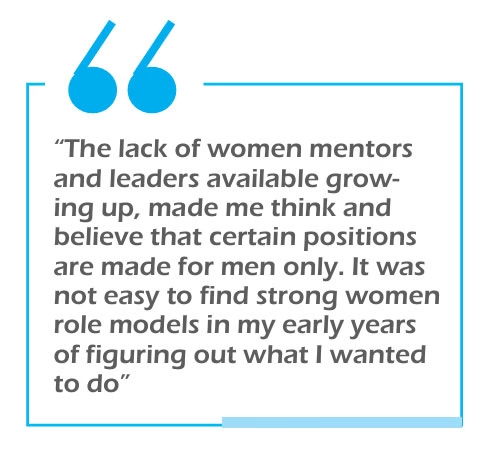
Dr. Mofokeng has also set ambitious goals for her career. “I’m working towards becoming an Established Researcher in the next few years, with the long-term goal of becoming a full Professor of Chemistry and Polymer Science,” she reveals. “I want to expand my research group and establish even more international collaborations, particularly in the areas of biodegradable materials and environmental sustainability.”
Dr. Julia Puseletso Mofokeng’s journey from a research assistant to a respected science researcher is an inspiring tale of perseverance, passion, and dedication to both science and community. Her research on biodegradable polymers holds the potential to address the global crisis of plastic pollution, while her commitment to mentoring young scientists is helping to shape the next generation of innovators. Her legacy will undoubtedly inspire countless women to follow in her footsteps and make their own mark in the world of science.
-

 Space & Physics5 months ago
Space & Physics5 months agoIs Time Travel Possible? Exploring the Science Behind the Concept
-

 Earth6 months ago
Earth6 months ago122 Forests, 3.2 Million Trees: How One Man Built the World’s Largest Miyawaki Forest
-

 Space & Physics6 months ago
Space & Physics6 months agoDid JWST detect “signs of life” in an alien planet?
-

 Know The Scientist5 months ago
Know The Scientist5 months agoNarlikar – the rare Indian scientist who penned short stories
-

 Society4 months ago
Society4 months agoShukla is now India’s first astronaut in decades to visit outer space
-

 Society4 months ago
Society4 months agoAxiom-4 will see an Indian astronaut depart for outer space after 41 years
-

 Earth4 months ago
Earth4 months agoWorld Environment Day 2025: “Beating plastic pollution”
-

 Society6 months ago
Society6 months agoRabies, Bites, and Policy Gaps: One Woman’s Humane Fight for Kerala’s Stray Dogs

